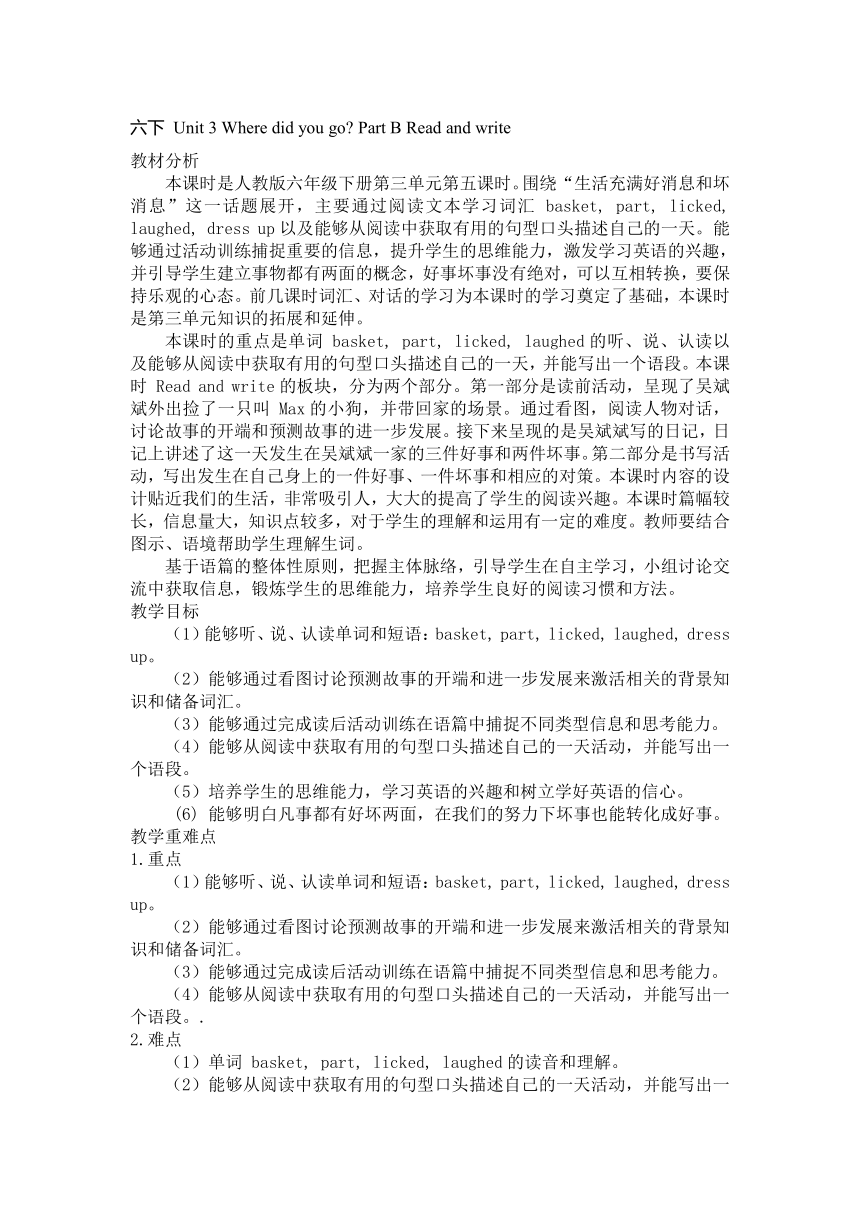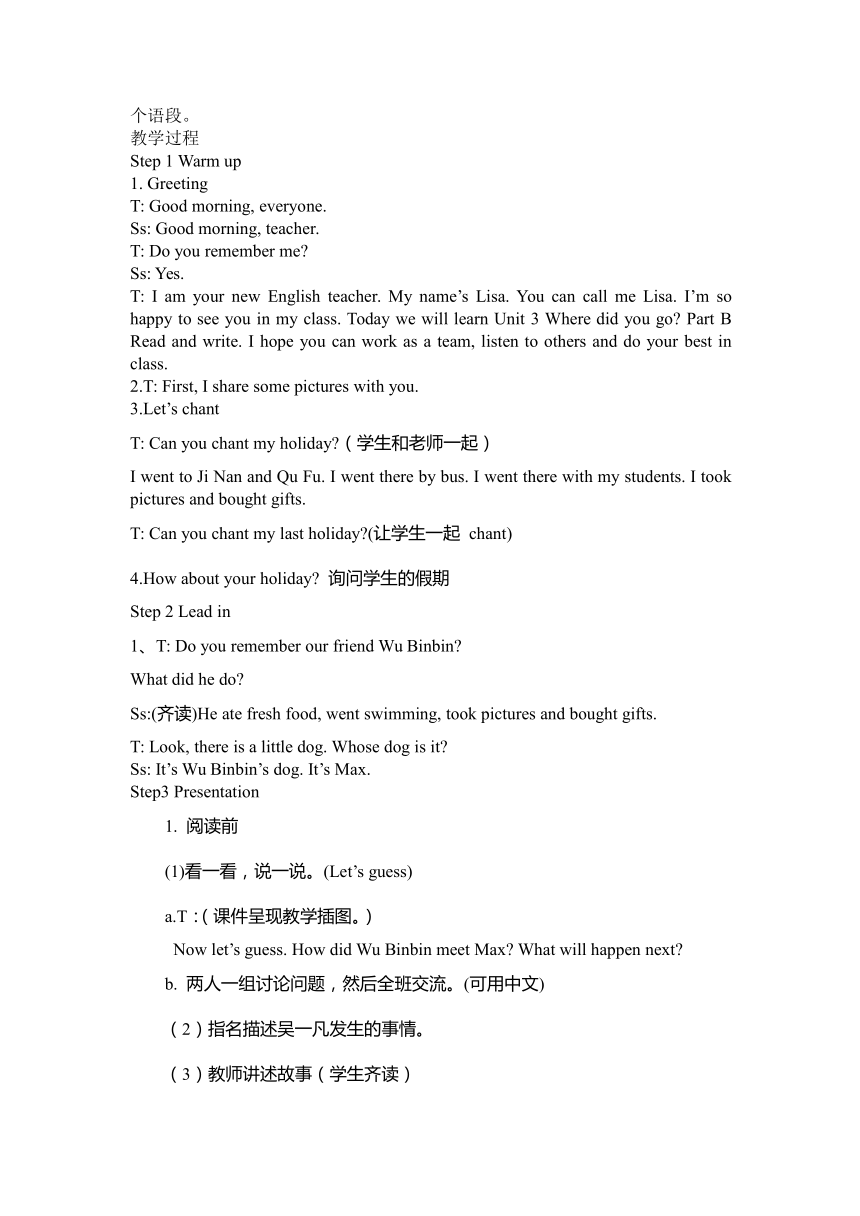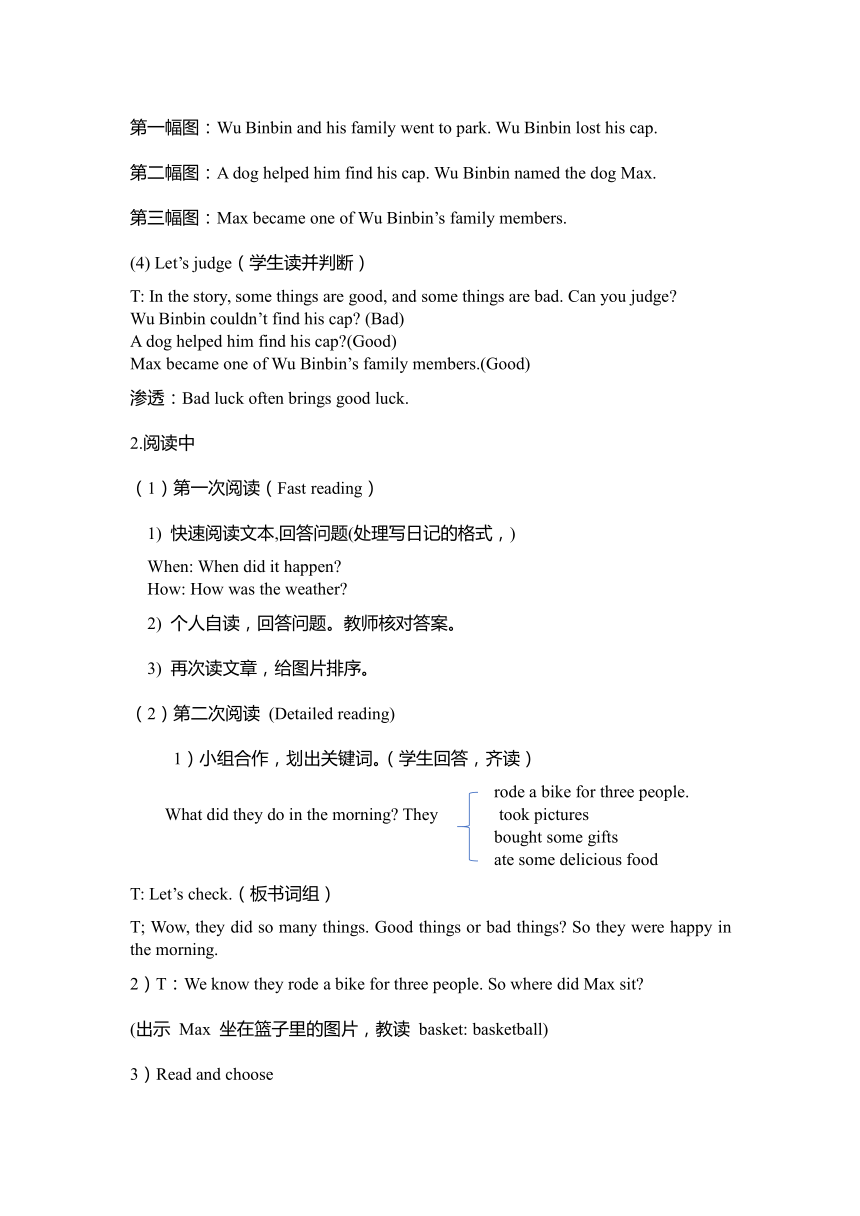Unit 3 Where did you go Part B Read and write 教案
文档属性
| 名称 | Unit 3 Where did you go Part B Read and write 教案 |  | |
| 格式 | docx | ||
| 文件大小 | 24.1KB | ||
| 资源类型 | 教案 | ||
| 版本资源 | 人教版(PEP) | ||
| 科目 | 英语 | ||
| 更新时间 | 2024-01-16 21:44:00 | ||
图片预览



文档简介
六下 Unit 3 Where did you go Part B Read and write
教材分析
本课时是人教版六年级下册第三单元第五课时。围绕“生活充满好消息和坏消息”这一话题展开,主要通过阅读文本学习词汇 basket, part, licked, laughed, dress up以及能够从阅读中获取有用的句型口头描述自己的一天。能够通过活动训练捕捉重要的信息,提升学生的思维能力,激发学习英语的兴趣,并引导学生建立事物都有两面的概念,好事坏事没有绝对,可以互相转换,要保持乐观的心态。前几课时词汇、对话的学习为本课时的学习奠定了基础,本课时是第三单元知识的拓展和延伸。
本课时的重点是单词 basket, part, licked, laughed的听、说、认读以及能够从阅读中获取有用的句型口头描述自己的一天,并能写出一个语段。本课时 Read and write的板块,分为两个部分。第一部分是读前活动,呈现了吴斌斌外出捡了一只叫 Max的小狗,并带回家的场景。通过看图,阅读人物对话,讨论故事的开端和预测故事的进一步发展。接下来呈现的是吴斌斌写的日记,日记上讲述了这一天发生在吴斌斌一家的三件好事和两件坏事。第二部分是书写活动,写出发生在自己身上的一件好事、一件坏事和相应的对策。本课时内容的设计贴近我们的生活,非常吸引人,大大的提高了学生的阅读兴趣。本课时篇幅较长,信息量大,知识点较多,对于学生的理解和运用有一定的难度。教师要结合图示、语境帮助学生理解生词。
基于语篇的整体性原则,把握主体脉络,引导学生在自主学习,小组讨论交流中获取信息,锻炼学生的思维能力,培养学生良好的阅读习惯和方法。
教学目标
(1)能够听、说、认读单词和短语:basket, part, licked, laughed, dress up。
(2)能够通过看图讨论预测故事的开端和进一步发展来激活相关的背景知识和储备词汇。
(3)能够通过完成读后活动训练在语篇中捕捉不同类型信息和思考能力。
(4)能够从阅读中获取有用的句型口头描述自己的一天活动,并能写出一个语段。
(5)培养学生的思维能力,学习英语的兴趣和树立学好英语的信心。
(6) 能够明白凡事都有好坏两面,在我们的努力下坏事也能转化成好事。教学重难点
1.重点
(1)能够听、说、认读单词和短语:basket, part, licked, laughed, dress up。
(2)能够通过看图讨论预测故事的开端和进一步发展来激活相关的背景知识和储备词汇。
(3)能够通过完成读后活动训练在语篇中捕捉不同类型信息和思考能力。
(4)能够从阅读中获取有用的句型口头描述自己的一天活动,并能写出一个语段。.
2.难点
(1)单词 basket, part, licked, laughed的读音和理解。
(2)能够从阅读中获取有用的句型口头描述自己的一天活动,并能写出一个语段。
教学过程
Step 1 Warm up
1. Greeting
T: Good morning, everyone.
Ss: Good morning, teacher.
T: Do you remember me
Ss: Yes.
T: I am your new English teacher. My name’s Lisa. You can call me Lisa. I’m so happy to see you in my class. Today we will learn Unit 3 Where did you go Part B Read and write. I hope you can work as a team, listen to others and do your best in class.
2.T: First, I share some pictures with you.
3.Let’s chant
T: Can you chant my holiday (学生和老师一起)
I went to Ji Nan and Qu Fu. I went there by bus. I went there with my students. I took pictures and bought gifts.
T: Can you chant my last holiday (让学生一起 chant)
4.How about your holiday 询问学生的假期
Step 2 Lead in
1、T: Do you remember our friend Wu Binbin
What did he do
Ss:(齐读)He ate fresh food, went swimming, took pictures and bought gifts.
T: Look, there is a little dog. Whose dog is it
Ss: It’s Wu Binbin’s dog. It’s Max.
Step3 Presentation
1. 阅读前
(1)看一看,说一说。(Let’s guess)
a.T:(课件呈现教学插图。)
Now let’s guess. How did Wu Binbin meet Max What will happen next
b. 两人一组讨论问题,然后全班交流。(可用中文)
(2)指名描述吴一凡发生的事情。
(3)教师讲述故事(学生齐读)
第一幅图:Wu Binbin and his family went to park. Wu Binbin lost his cap.
第二幅图:A dog helped him find his cap. Wu Binbin named the dog Max.
第三幅图:Max became one of Wu Binbin’s family members.
(4) Let’s judge(学生读并判断)
T: In the story, some things are good, and some things are bad. Can you judge
Wu Binbin couldn’t find his cap (Bad)
A dog helped him find his cap (Good)
Max became one of Wu Binbin’s family members.(Good)
渗透:Bad luck often brings good luck.
2.阅读中
(1)第一次阅读(Fast reading)
1) 快速阅读文本,回答问题(处理写日记的格式,)
When: When did it happen
How: How was the weather
2) 个人自读,回答问题。教师核对答案。
3) 再次读文章,给图片排序。
(2)第二次阅读 (Detailed reading)
1)小组合作,划出关键词。(学生回答,齐读)
rode a bike for three people.
What did they do in the morning They took pictures
bought some gifts
ate some delicious food
T: Let’s check.(板书词组)
T; Wow, they did so many things. Good things or bad things So they were happy in the morning.
2)T:We know they rode a bike for three people. So where did Max sit
(出示 Max 坐在篮子里的图片,教读 basket: basketball)
3)Read and choose
T: And where did they go in the afternoon
A. stayed in the hotel. B. went to the park.
What did they do in the afternoon
A. Took pictures B. dressed up and made a funny play.
(教读并解释 dressed up,出示几张照片)
4)T:We know they stayed in the hotel in the afternoon. Why did they stay in the hotel (出示 mum躺在床上的图片,阅读第二段并回答问题)学生回答,教师板书 ate bad fruit和 didn’t feel well Good things or bad things
5) T:Look at the picture, Robin has a tail. Please read and answer.
What did Robin do
学生回答。
教师讲解 play the part of 中 part的意思。
T:And, what did Max do
学生回答。教师教读单词 licked.讲一下发音。
6)T:They made a funny play in the afternoon, so were they happy
学生回答。教师讲解单词 laughed.(出示图片辅助)
7)T:How do you think of Wu’s Day
A. It was good. B. It was bad. C. It was...
T:Some of you think it was boring. Some of you think it was interesting.
How does Wu Binbin think of his day
学生回答并齐读:It was a bad day but also a good day.
3.Practice
(1)Listen and imitate
Pay attention to the pronunciation and intonation.
(2)Read in groups(选择其中的一个段落读)
(3)Read together Read after one Read by yourself
(4)Show time
(5)写一写。再次阅读文本,找出这一天发生在吴斌斌一家的三件好事和坏事,用线画出。
1)小组讨论,先说一说,然后在写。
Bad things Good things
展示学生书写结果
Step 4 Production
Now write your bad but good day.
1)学生回忆六年小学生活中最难忘的一天,这一天发生了什么样的坏事,你是怎么做的,怎样将坏事变成好事的。教师先示范。学生分小组讨论,代表讲述,然后书写。
2)展示学生的书写。教师向学生渗透观念:事情都有两面,好事坏事没有绝对,可以互相转换,因此要保持乐观的心态,努力把坏事变好事。
情感渗透
Things have two sides, good things and bad things are not absolute, they can be transferred to each other. So maintain an optimistic attitude, try to turn bad into good.(事情都有两面,好事坏事没有绝对,可以互相转换,因此要保持乐观的心态,努力把坏事变好事)
T:上升到家国情怀
Boys and girls, our country was attracted by coronavirus. Our country fell into special war without smoke. It is a bad thing. But everyone keep an optimistic attitude. They do their best to help country. So everybody, please study hard, keep optimistic attitude. Do our best to help our country.观看抗疫宣传片,同时情感渗透,从个人上升到国家。
Step 5 progress
Summary: What have you learned today
Step 6 Homework
1. Read the diary and try to retell it.
2. Write about your bad and good day.
板书设计
Unit 3 Where did you go Part B Read and write
Good rode a bike Bad didn’t feel well
took pictures stayed the hotel
bought gifts
ate delicious food
dressed up
made a funny play
jumped licked laughed
It was a bad day but also a good day
教材分析
本课时是人教版六年级下册第三单元第五课时。围绕“生活充满好消息和坏消息”这一话题展开,主要通过阅读文本学习词汇 basket, part, licked, laughed, dress up以及能够从阅读中获取有用的句型口头描述自己的一天。能够通过活动训练捕捉重要的信息,提升学生的思维能力,激发学习英语的兴趣,并引导学生建立事物都有两面的概念,好事坏事没有绝对,可以互相转换,要保持乐观的心态。前几课时词汇、对话的学习为本课时的学习奠定了基础,本课时是第三单元知识的拓展和延伸。
本课时的重点是单词 basket, part, licked, laughed的听、说、认读以及能够从阅读中获取有用的句型口头描述自己的一天,并能写出一个语段。本课时 Read and write的板块,分为两个部分。第一部分是读前活动,呈现了吴斌斌外出捡了一只叫 Max的小狗,并带回家的场景。通过看图,阅读人物对话,讨论故事的开端和预测故事的进一步发展。接下来呈现的是吴斌斌写的日记,日记上讲述了这一天发生在吴斌斌一家的三件好事和两件坏事。第二部分是书写活动,写出发生在自己身上的一件好事、一件坏事和相应的对策。本课时内容的设计贴近我们的生活,非常吸引人,大大的提高了学生的阅读兴趣。本课时篇幅较长,信息量大,知识点较多,对于学生的理解和运用有一定的难度。教师要结合图示、语境帮助学生理解生词。
基于语篇的整体性原则,把握主体脉络,引导学生在自主学习,小组讨论交流中获取信息,锻炼学生的思维能力,培养学生良好的阅读习惯和方法。
教学目标
(1)能够听、说、认读单词和短语:basket, part, licked, laughed, dress up。
(2)能够通过看图讨论预测故事的开端和进一步发展来激活相关的背景知识和储备词汇。
(3)能够通过完成读后活动训练在语篇中捕捉不同类型信息和思考能力。
(4)能够从阅读中获取有用的句型口头描述自己的一天活动,并能写出一个语段。
(5)培养学生的思维能力,学习英语的兴趣和树立学好英语的信心。
(6) 能够明白凡事都有好坏两面,在我们的努力下坏事也能转化成好事。教学重难点
1.重点
(1)能够听、说、认读单词和短语:basket, part, licked, laughed, dress up。
(2)能够通过看图讨论预测故事的开端和进一步发展来激活相关的背景知识和储备词汇。
(3)能够通过完成读后活动训练在语篇中捕捉不同类型信息和思考能力。
(4)能够从阅读中获取有用的句型口头描述自己的一天活动,并能写出一个语段。.
2.难点
(1)单词 basket, part, licked, laughed的读音和理解。
(2)能够从阅读中获取有用的句型口头描述自己的一天活动,并能写出一个语段。
教学过程
Step 1 Warm up
1. Greeting
T: Good morning, everyone.
Ss: Good morning, teacher.
T: Do you remember me
Ss: Yes.
T: I am your new English teacher. My name’s Lisa. You can call me Lisa. I’m so happy to see you in my class. Today we will learn Unit 3 Where did you go Part B Read and write. I hope you can work as a team, listen to others and do your best in class.
2.T: First, I share some pictures with you.
3.Let’s chant
T: Can you chant my holiday (学生和老师一起)
I went to Ji Nan and Qu Fu. I went there by bus. I went there with my students. I took pictures and bought gifts.
T: Can you chant my last holiday (让学生一起 chant)
4.How about your holiday 询问学生的假期
Step 2 Lead in
1、T: Do you remember our friend Wu Binbin
What did he do
Ss:(齐读)He ate fresh food, went swimming, took pictures and bought gifts.
T: Look, there is a little dog. Whose dog is it
Ss: It’s Wu Binbin’s dog. It’s Max.
Step3 Presentation
1. 阅读前
(1)看一看,说一说。(Let’s guess)
a.T:(课件呈现教学插图。)
Now let’s guess. How did Wu Binbin meet Max What will happen next
b. 两人一组讨论问题,然后全班交流。(可用中文)
(2)指名描述吴一凡发生的事情。
(3)教师讲述故事(学生齐读)
第一幅图:Wu Binbin and his family went to park. Wu Binbin lost his cap.
第二幅图:A dog helped him find his cap. Wu Binbin named the dog Max.
第三幅图:Max became one of Wu Binbin’s family members.
(4) Let’s judge(学生读并判断)
T: In the story, some things are good, and some things are bad. Can you judge
Wu Binbin couldn’t find his cap (Bad)
A dog helped him find his cap (Good)
Max became one of Wu Binbin’s family members.(Good)
渗透:Bad luck often brings good luck.
2.阅读中
(1)第一次阅读(Fast reading)
1) 快速阅读文本,回答问题(处理写日记的格式,)
When: When did it happen
How: How was the weather
2) 个人自读,回答问题。教师核对答案。
3) 再次读文章,给图片排序。
(2)第二次阅读 (Detailed reading)
1)小组合作,划出关键词。(学生回答,齐读)
rode a bike for three people.
What did they do in the morning They took pictures
bought some gifts
ate some delicious food
T: Let’s check.(板书词组)
T; Wow, they did so many things. Good things or bad things So they were happy in the morning.
2)T:We know they rode a bike for three people. So where did Max sit
(出示 Max 坐在篮子里的图片,教读 basket: basketball)
3)Read and choose
T: And where did they go in the afternoon
A. stayed in the hotel. B. went to the park.
What did they do in the afternoon
A. Took pictures B. dressed up and made a funny play.
(教读并解释 dressed up,出示几张照片)
4)T:We know they stayed in the hotel in the afternoon. Why did they stay in the hotel (出示 mum躺在床上的图片,阅读第二段并回答问题)学生回答,教师板书 ate bad fruit和 didn’t feel well Good things or bad things
5) T:Look at the picture, Robin has a tail. Please read and answer.
What did Robin do
学生回答。
教师讲解 play the part of 中 part的意思。
T:And, what did Max do
学生回答。教师教读单词 licked.讲一下发音。
6)T:They made a funny play in the afternoon, so were they happy
学生回答。教师讲解单词 laughed.(出示图片辅助)
7)T:How do you think of Wu’s Day
A. It was good. B. It was bad. C. It was...
T:Some of you think it was boring. Some of you think it was interesting.
How does Wu Binbin think of his day
学生回答并齐读:It was a bad day but also a good day.
3.Practice
(1)Listen and imitate
Pay attention to the pronunciation and intonation.
(2)Read in groups(选择其中的一个段落读)
(3)Read together Read after one Read by yourself
(4)Show time
(5)写一写。再次阅读文本,找出这一天发生在吴斌斌一家的三件好事和坏事,用线画出。
1)小组讨论,先说一说,然后在写。
Bad things Good things
展示学生书写结果
Step 4 Production
Now write your bad but good day.
1)学生回忆六年小学生活中最难忘的一天,这一天发生了什么样的坏事,你是怎么做的,怎样将坏事变成好事的。教师先示范。学生分小组讨论,代表讲述,然后书写。
2)展示学生的书写。教师向学生渗透观念:事情都有两面,好事坏事没有绝对,可以互相转换,因此要保持乐观的心态,努力把坏事变好事。
情感渗透
Things have two sides, good things and bad things are not absolute, they can be transferred to each other. So maintain an optimistic attitude, try to turn bad into good.(事情都有两面,好事坏事没有绝对,可以互相转换,因此要保持乐观的心态,努力把坏事变好事)
T:上升到家国情怀
Boys and girls, our country was attracted by coronavirus. Our country fell into special war without smoke. It is a bad thing. But everyone keep an optimistic attitude. They do their best to help country. So everybody, please study hard, keep optimistic attitude. Do our best to help our country.观看抗疫宣传片,同时情感渗透,从个人上升到国家。
Step 5 progress
Summary: What have you learned today
Step 6 Homework
1. Read the diary and try to retell it.
2. Write about your bad and good day.
板书设计
Unit 3 Where did you go Part B Read and write
Good rode a bike Bad didn’t feel well
took pictures stayed the hotel
bought gifts
ate delicious food
dressed up
made a funny play
jumped licked laughed
It was a bad day but also a good day
